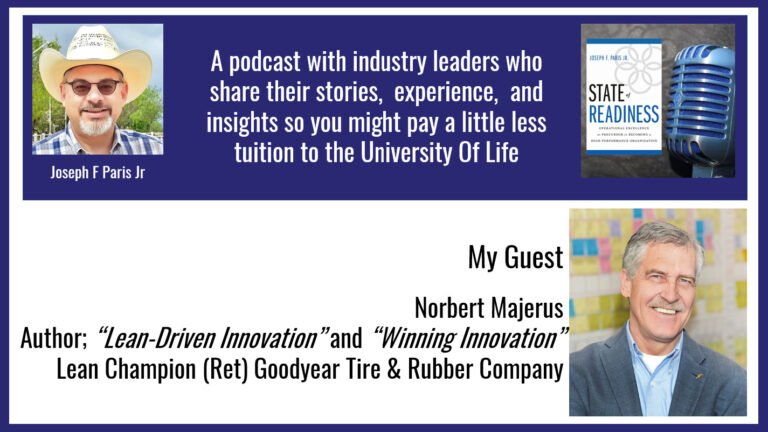Case Study: Operational Excellence Audits as Key Driver
Background: From 1987 until 2009 I was CEO of Interbake Foods, a food processing company headquartered in Richmond, Virginia. We competed in four business segments: Girl Scout cookies, contract manufacturing for branded companies, private label cookies sold to retailers, and baked ingredients for ice cream processors (primarily ice cream sandwich cookies and cones). Interbake had no brands of its own and competed on the basis of operational excellence. To be successful without the power of a brand we had to be a low cost, high quality manufacturing company with superior customer service. If we were operationally excellent at those three competitive parameters, we could profitably grow our business. If we failed to achieve operational excellence in any one of those elements, we were doomed to mediocrity or even failure.
In 1989, we began a journey to be the best in our industry on cost, quality and customer service. To get there, we chose our core capabilities by:
- Automating our top twenty five products, which were 70% of our total volume;
- Implementing Enterprise Resource Planning (ERP) and getting to a world class level;
- Implementing statistical process control (SPC) on all of our production lines, thus driving process control to the operator level with line leaders focused on process improvement.
We felt strongly that these three initiatives carried to a world class performance level would deliver world class results on our three key competitive parameters.
We quickly discovered that we had to add a fourth strategic initiative. We were generating a lot of data from our ERP and SPC initiatives, but there was considerable variation in the quality of the decision making and problem solving being done with that data. We also found that installation and startup of our significant capital investments were taking far longer and were more costly than anticipated. Our fourth strategic initiative was to choose to adopt rational process thinking and project management skills as foundational capabilities for every salaried employee and key operator in the business. We came to believe that mastery of rational process thinking throughout the organization would not only improve our results, but would also profoundly affect the culture, improving the capability of teams to work more collaboratively and effectively.
Driving Change: Since we had none of these capabilities in January of 1989, we clearly had a lot on our plate. What were the key drivers to make these changes a permanent, sustainable reality in our business?
Training
We had to train a lot of people in ERP processes, statistical process control techniques, and rational process tools. We decided to own the training. These core capabilities would be trained by internal resources and those resources would come from senior staff and line managers. This choice would highlight that these capabilities were strategic, leadership driven (not HR driven, nor flavor of the month.)
Leadership
We decided that we would train leadership first and that every executive would have to be as knowledgeable about these core capabilities as any operator. Several executives became trainers. As CEO, I attended a two week Train the Trainer program, along with three other executives, and became a certified instructor in problem solving and decision making tools. We committed to training every salaried employee in a four day program and every hourly machine operator and maintenance employee in a two day program within three years, ultimately over 1000 employees. We also committed to building the support infrastructure within the business to provide feedback, coaching and incentives to embrace, master and use what was learned in the training; as well as to build use of our core capabilities into every conversation with our people.
Support Infrastructure
On-going skill development support: The best participants from training events were given additional training and opportunities to become process facilitators and coaches. From that group, the best of the best were given even more training to become trainers themselves.
Performance Management System: Knowledge and use of our core capabilities were built into our performance management system (KEA’s, 360 feedback, promotion criteria.)
Process Integration: The requirement to use our core capabilities was built into every applicable process in the business. For example, no capital request above $50,000 could be submitted without a KT Decision Analysis attached. There could be no project startup without a documented KT Potential Problem Analysis. The ERP process became THE way we managed inputs and outputs to the business. SPC became universal on our plant floors.
Audits: The key driver for change was our use of audits. We did ERP audits, ISO audits and, most importantly, Operational Excellence (OE) audits. For the OE audits, a senior executive team usually led by me, would visit each of our manufacturing plants every six months. We had unique audit forms for each position in the plant: key operator, line supervisor, department manager, and plant manager. The audit questions defined in detail what someone in the position would be doing if they were performing in our desired future state. As auditors, question by question, we would look for demonstrated performance or documented evidence that the person being audited was working that way. Over a three day period we would interview every key operator, every line supervisor, department manager and the plant manager on all three shifts. Every deficiency we found was treated as an on the spot coaching opportunity. The fact that the senior team was there digging deep into that level of detail demonstrated we were serious and that this was vital to the future of the business. We also found that even after just the first audit we really knew what was happening in each plant. This was a very different experience from sitting in a conference room and listening to the management team tell us what was going on and very different from a typical plant walk through.
We would score the plant at the end of the audit; note the gaps; advise on priorities for allocating resources to close the gaps; and promise to return in six months. This put continuous pressure on the plant management team to focus on identified deficiencies and drive improvements before the next audit. Since they had copies of all the audit sheets for every one interviewed, they could be targeted in where additional skill development was needed.
Interestingly, we found key operators grew to love being audited. The audits strongly communicated that their jobs were important enough for the CEO, VP of Operations, or VP of Sales to be there on every shift to talk to them about it one–on-one. They were eager to demonstrate their growing mastery.
Results: We achieved and sustained Class A ERP status. We became the first baking company in North America to be ISO certified as a company at all locations. We reached a world class level of performance in our use of SPC.
How was that reflected in performance? We more than doubled our pounds produced per employee while cutting our plant overhead cost per pound produced in half. Our order fill rate was consistently at around 99.8% with low raw materials and finished goods inventories and production schedules that were 80% stable during a week. In our consumer products business units, we averaged less than two complaints from consumers per million packages sold. We achieved high market shares in the four niche markets where we chose to compete. All of this was accomplished with what evolved towards an employee to supervisor ratio of about 60 to one. Two of our smaller plants with 90 to 100 employees, ran 24 hours a day with only one manager on site.
This is definitely not a quick fix. It takes a long term view and a strong senior leadership commitment to make a meaningful difference in how an organization performs. A lot of documented experiences strongly support that five to seven years at a minimum are required to make a systemic, sustainable organization wide change.
Why make that monumental an effort? Because it is the only way for an organization to really drive long term sustainable superior results. But the commitment must flow from an organization’s strategy, not just from anyone’s personal likes or preferences.
The core skill requirements of an organization should flow out of strategy. As part of the strategic planning process, the executive leadership team should be asking: What core skills does the organization require to realize its strategy?Constant, flawless new product launches (project management)
- Superior, consultative selling capability (selling skills)
- Lowest cost manufacturing (lean/six sigma)
- Exceptional product quality (SPC)
- Superior customer issue resolution (troubleshooting)
- Superior order fill rates (ERP)
What do our people have to be great at to achieve the competitive advantage we’ve targeted? No enterprise can be great at everything. We have to choose the capabilities that matter to create differentiation and competitive advantage. And having chosen, we must invest to create and sustain those capabilities. We have seen so many organizations frustrated because they have communicated their strategy to their people and then expected people to execute that strategy. But without consciously and deliberately giving people the knowledge, tools, skills and support to be able to execute the strategy, they have set everyone up for failure.
- If the core skills required are strategic, then we should be able to get not just C-Suite support, but their direct involvement in developing and modeling those core skills. Support is never enough to drive change. People hear what leaders say, but they pay really close attention to what leaders do. If the leaders say we will use a formal, structured decision making process for all significant decisions and they master and always use that process, everyone else will quickly get on board. If, on the other hand, the leadership continues to make decisions by intuition and personal preference and expects everyone else to use the structured process, people will hunker down and wait until this fad also passes on.
- If the core skills are strategic, then the C-Suite should be motivated to invest to build the infrastructure necessary to get from training to skill mastery; to get from class room instruction to using the strategic skills with a high level of proficiency every day in every applicable situation. The C-Suite must be investing not just money, but time; time to role model, time to monitor and audit, time to communicate and inspire.
By Ray Baxter
 Independent consultant and interim executive with extensive experience in change management, effective implementation of strategic initiatives, rapid integration of acquisitions, strong group facilitation skills using Kepner-Tregoe rational process methodologies. Most recently, CEO of Kepner-Tregoe Inc, a global clear thinking capability development and consulting company headquartered in Princeton, NJ.
Independent consultant and interim executive with extensive experience in change management, effective implementation of strategic initiatives, rapid integration of acquisitions, strong group facilitation skills using Kepner-Tregoe rational process methodologies. Most recently, CEO of Kepner-Tregoe Inc, a global clear thinking capability development and consulting company headquartered in Princeton, NJ.
Previously, thirty years experience in food processing industry including 22 years as CEO of $300 million division of $20 billion public company. Directly involved in executing integration of three acquisitions, implementing integrated information system, moving business to world class level performance in ERP and Statistical Process Control, and leading a major asset restructuring.
Contact him at raybaxter1@me.com.







